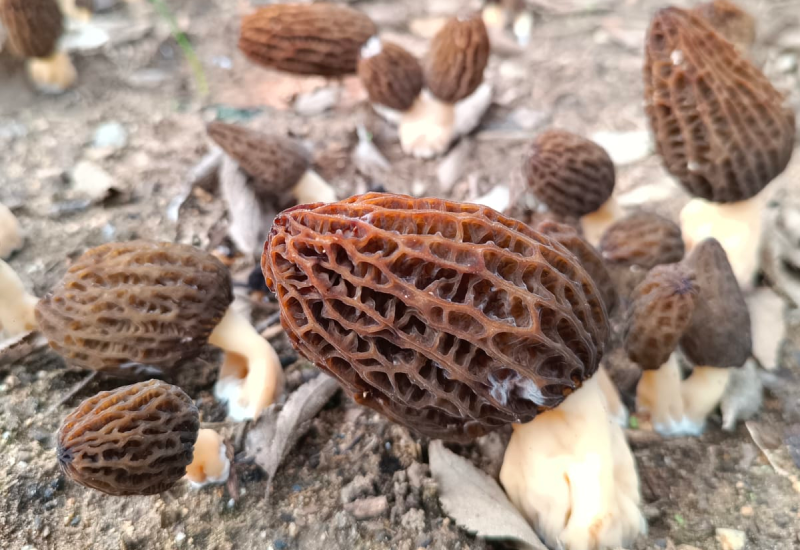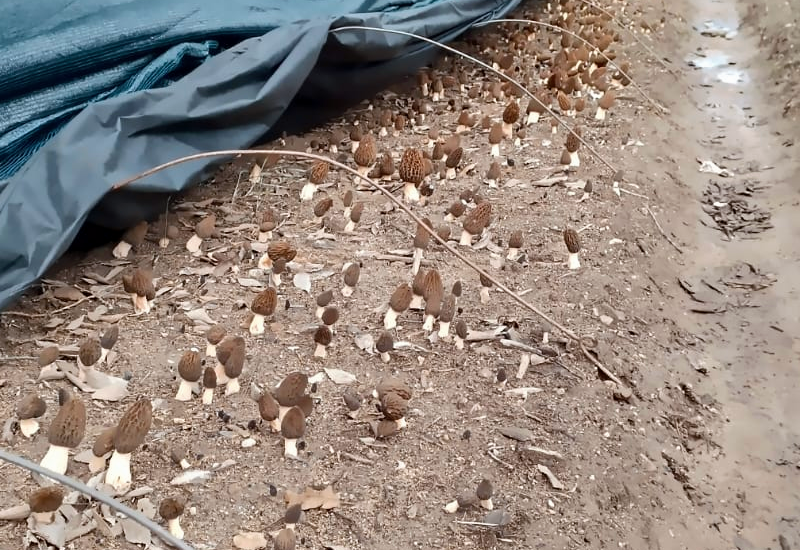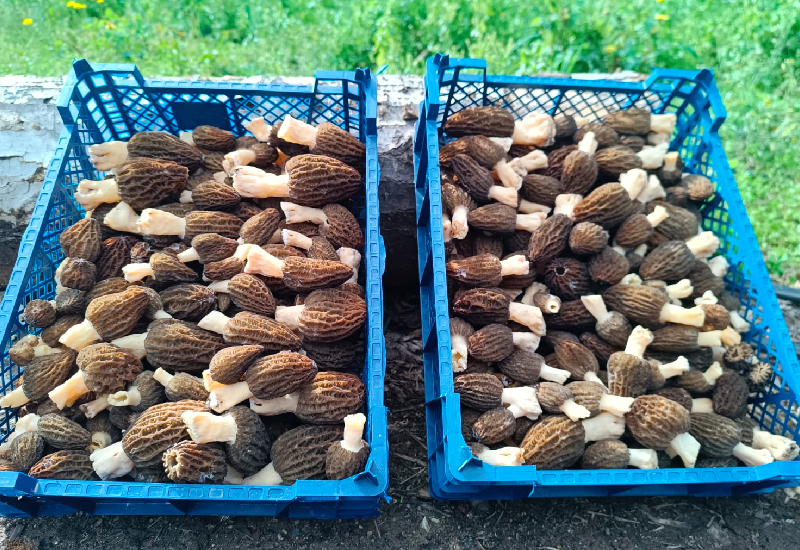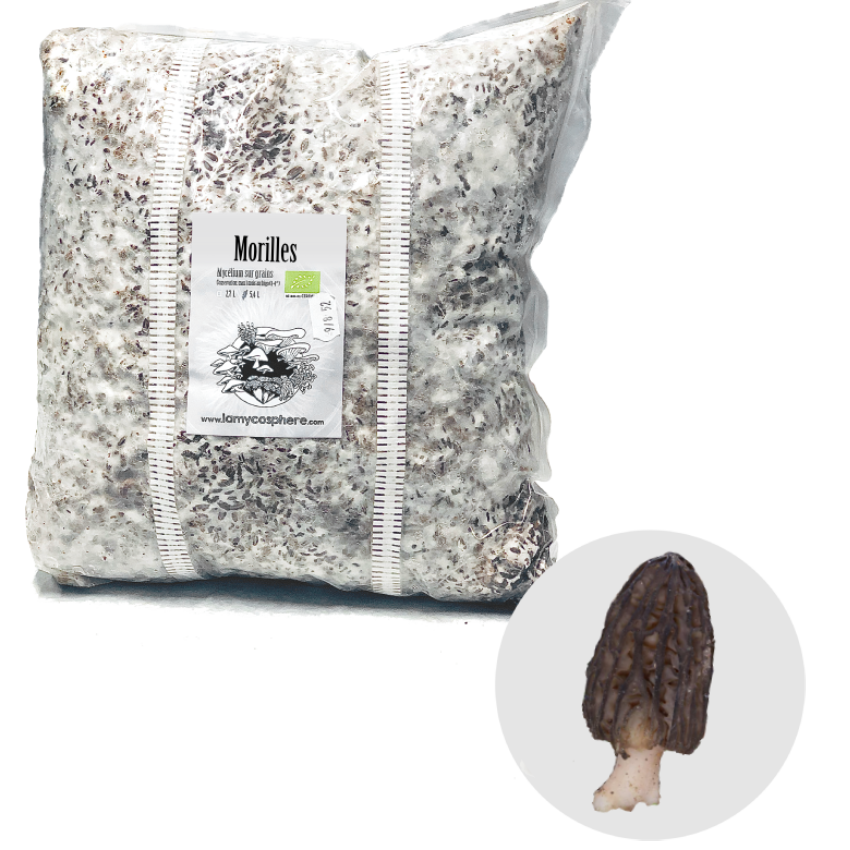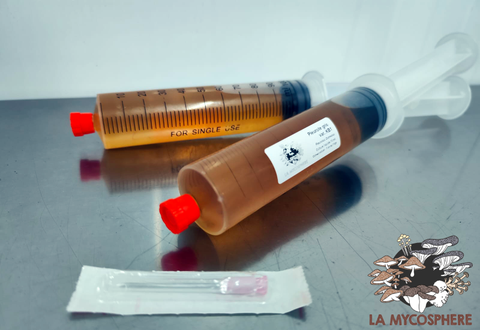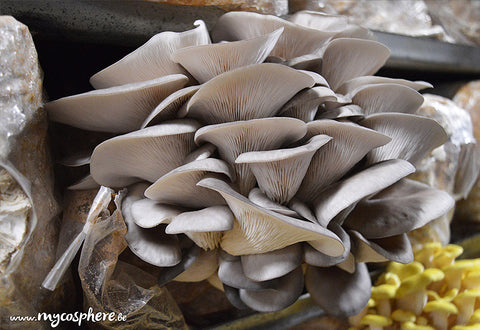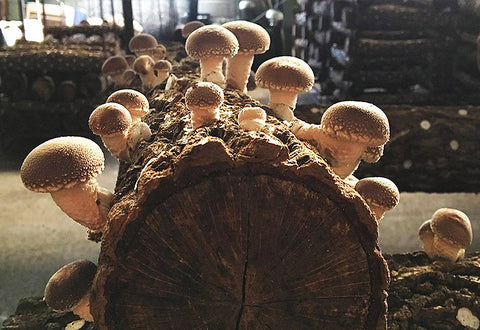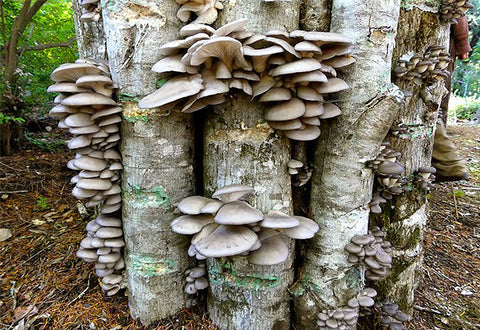Pre-Order Mycelium on Organic Morel Grains
- Pre-order: orders will be delivered in autumn 2025, as soon as temperatures allow, or according to your desired delivery date. If you order other items in the same order, they will be shipped at the same time.
- The queen of the underbrush, excellent culinary flavor
- "Experience at home the cultivation of morels: in the garden, in a greenhouse, in the undergrowth. Inoculation recommended between October and December."
- To combine with our nutrient bags
- Mycelium on mycelium on grains grains produced in certified laboratory BE-BIO-01 Agriculture Belgium
-
+- 2 weeks. Consult all our deadlines
Black morels, Morchella importuna.
The black morel, a cultivable gastronomic treasure
Excellent edible mushroom, the black morel naturally grows in the spring in forests, often on calcareous soils. Appreciated for its refined taste and unique texture, it is particularly sought after by gourmets.
Our morel strain stands out for its ability to be cultivated under controlled conditions. Unlike certain varieties that establish symbiotic relationships with trees, it is primarily saprotrophic: it feeds on decomposing organic matter without requiring a living host. This particularity allows its cultivation on substrate, making its production possible outside of its natural habitat.
Note, however, that we recommend outdoor cultivation. The success of the cultivation depends on many parameters, including the presence of certain soil bacteria that help with fruiting.
Mycelium preservation: If you do not use the mycelium within 3 to 5 days of receipt, it is best to store it in the refrigerator. It can then be kept for 1 to 2 months before use.
In summary:
| Mycelium bag size | Sown area | Number of nutritional bags needed | Harvest expected |
|---|---|---|---|
| 1,5 kg | Approximately 5 m² | 5 nutrient bags | Up to 1 kg of morels |
| 3 kg | Approximately 10 m² | 10 nutrient bags | Up to 2 kg of morels |
Our commitment to quality:
We produce our mycelia under laboratory conditions, thus ensuring the purity of the varieties and optimal quality.

We produce our myceliums in a 100% organic way, and all our products are certified "BE-BIO-01, Agriculture Belgium" by CERTISYS.
Note : The cultivation of morel mushrooms is more complex than most other varieties we sell on our site. Its cultivation remains relatively experimental, but research in recent years and the sharing of information have significantly advanced this cultivation. We guarantee the quality of the strain, but we cannot guarantee the success of the cultivation. Please feel free to share your feedback and experiences with this cultivation.
🌱 Growing conditions
Morels are generally cultivated outdoors: in the vegetable garden under shade cloth, in a shaded greenhouse, or in the undergrowth.
Seedlings are generally sown at the end of autumn and the beginning of winter, between October and December. Temperatures should no longer exceed 20° (just above the ground).
A late sowing can be done until the end of December in certain regions that do not have too much frost. For colder regions, prefer a spring sowing after the last frosts.

The biotope:
The goal is to reproduce the naturally optimal conditions for morels. In most cases, a shelter in the form of a tunnel with a shading veil will be necessary. The mycelium needs shade to develop well and cannot tolerate direct sunlight. Think of the understory or forest edge, and try to replicate this lighting.
Avoid cultivated soils that have contained fungicides such as copper (found in Bordeaux mixture, for example, which is allowed in organic farming), as well as acidic soils or those rich in tannins. Morels prefer a calcareous, basic soil. The ideal pH is around 7 or 8, measurable with pH test strips. It may be necessary to amend the soil with calcium carbonate, white Meudon chalk, or limestone lime. Avoid lime rich in magnesium, which is generally not suitable for mushroom cultivation.
As a secondary decomposer, morel mycelium will appreciate soil rich in already pre-decomposed organic matter. If you have wood chips, the ideal would be to let them compost for a year, then incorporate them into the top 5 centimeters of soil in spring or summer. The manure should also be 2 to 3 years old before being mixed into the soil for morels.
Morel mycelium withstands light frosts well. If prolonged frosts below -5° are expected, try to further protect your mycelium by covering your tunnel with a thicker veil or tarp.

🔧 Method (I.T.)
1. Inoculation (seeding):
There are two options:
- The mycelium is scattered by hand (200 to 300 grams of mycelium per square meter) and then covered or buried under 2 to 4 cm of soil.
- The mycelium is buried in "pockets" of 100 to 200 grams, covered with 2 to 4 cm of soil (2 to 3 pockets per square meter). With this technique, the mycelium can be placed in terracotta pots, positioned with the hole facing upwards and closed at the bottom. It is a more laborious method, but it protects the mycelium from contamination, limits the impact of rodents, and accelerates the "deflagration" of the mycelium by giving it a direction with the opening facing upwards, while allowing good respiration of the mycelium.
Some recommend, at the same time as inoculation, a light sowing of cereals (wheat, rye, etc.) as ground cover. This light vegetation will provide natural shade to the mycelium, some sugars through the roots, as well as protection against winds and a more constant and favorable humidity for the development of the mycelium. A sowing that is too dense is not advised.
The soil before inoculation must be well moist to allow the proper development of the mycelium, either after rain or after watering.
2. The deflagration of the mycelium:
The morel mycelium will start from the grain spawn to explore its environment. It will appear on the soil surface in eccentric circles, called deflagrations. Depending on the biotopes and temperatures, this can take 1 to 3 weeks and exhibit more or less pronounced features.

3. Feeding:
The morel will first feed on its so-called "endogenous" food, present in the soil. Quickly, the morel mycelium will need to be fed with so-called "exogenous" food, placed directly on the soil. This greedy mushroom requires inputs of sugars (starches, cellulose, and simple sugars). We recommend our nutrient bags, to be placed with an opening towards the soil. Another technique involves providing cooked apples, cut in half, placed with the opening on the mycelium's outburst.
The morel mycelium will thus move from a rich environment (its inoculation point) through a nutrient-poor environment (the soil) to once again a sugar-rich environment (the exogenous food). This alternation of environmental richness will allow the mycelium to properly develop its sclerotia, which will then produce beautiful morels.
These food bags will be left in place for a few weeks, without touching them, except in cases of contamination by mold or insects. By carefully observing the bags, you should see the mycelium colonize the grain spawn in the days following their placement. Around March-April, when temperatures begin to rise, about 2 to 3 weeks before fruiting, these bags will be removed.
4. Incubation:
The total incubation takes between 1.5 and 4 months. After feeding, the mycelium will gradually take on orange then brown colors. At this stage, the mycelium will draw its resources from the exogenous food to bring them into the soil, a poor environment. It will concentrate and store its resources there in the form of sclerotia, which will later produce beautiful morels.
5. Watering:
Mushrooms being composed of nearly 90% water, humidity is a crucial factor. The soil must be well watered before inoculation. A few weeks before fruiting, the soil should be watered regularly. Avoid strong water jets that could damage the surface mycelium. Prefer gentle watering with perforated hoses or micro-droplets, preferably in the morning. In case of heavy rain, protect your mycelium well with a double shade cloth if necessary.
6. Fruiting:
Mushrooms will start to develop when soil temperatures rise. At this stage, the mycelium will need more light. This can happen naturally, as the days begin to lengthen, but you can also remove part of the shade cloth during the day. At night, always cover them with a cloth to limit the risk of frost.

The appearance of "primordia" (mushroom beginnings) is a delicate period. Primordia are very sensitive and fragile. It is therefore necessary to be vigilant during this period by avoiding direct sunlight, drying wind, heavy rain, frost, etc., while providing them with some light and constant humidity.
Watering is preferably done by capillarity: direct wetting of the morels is avoided, but watering is done around or on the paths. In case of high heat, it is possible to water directly by sprinkling only in the morning, before the temperature rises. The water will then be quickly absorbed and evaporated.
7. The harvests generally take place between February and May, when temperatures rise to around 20° and the soil warms up. Keep the soil moist throughout the growth of the mushrooms. Morels are harvested when they measure about 10 cm.
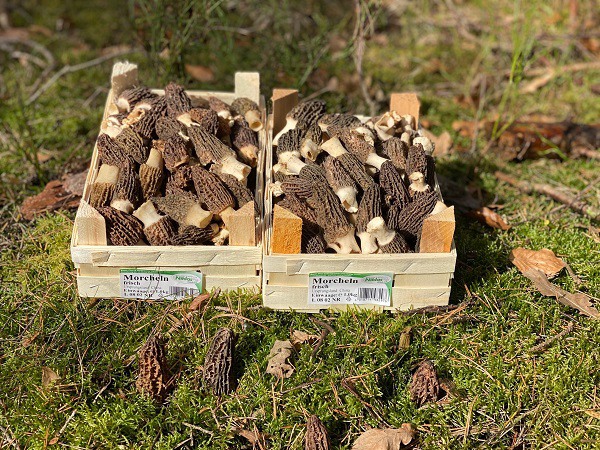
Protection against Parasites
Morel cultivation can be threatened by various parasites, including insects and molds. To minimize these risks, install a shade cloth and a protective tarp. These devices help create a controlled environment, reducing the risk of contamination.
For effective biological control against larvae, slugs, and other pests, you can use Bacillus thuringiensis (BT), a bacterium naturally found in the soil that specifically targets harmful insects without damaging the crop. Be sure to follow the manufacturer's instructions for proper use.
For slugs hungry after winter, ferric phosphate is often used, also authorized in organic farming. We recommend it only at the appearance of the first primordia. The blue granules are coated with a flour attractive to slugs, but which unfortunately also tends to promote the presence of dactylium, a mold that attacks young morels. Dactylium is favored by constant humidity and a lack of evaporation. You will therefore need to adjust your shelters to increase or limit evaporation, humidity, and soil temperature to give our beautiful morels the best chance.
Bird and Rodent Management
Birds and rodents can also pose a threat to morel crops by digging in the soil or uprooting young mushrooms. To deter them, you can use protective nets or natural repellents. Installing physical barriers around the cultivation areas can also help protect your harvest.
📊 Productivity
Productivity depends on several factors:
- The quality of the substrate (soil, organic matter, soil bacteria, etc.),
- The weather,
- The maintenance of the culture or the gardener's "fungal hand."
With a well-executed cultivation, you can expect to harvest between 500 and 1500 grams per square meter.

⚠️ Precautions
Morels must be cooked. They are toxic when raw.
If this is the first time you are eating this species, it is best to start with a small amount to check for possible allergies, even after cooking.
Allow about 10 minutes of cooking time in the pan or pot for proper cooking.
❓ FAQ
Is it normal for my mycelium to be brown?
The morel mycelium goes through different stages of maturity, which gives it white, orange, and then brown colors.
Should I water my crop?
Being rather a winter crop, the soils are generally naturally moist. Two periods must be taken into account: before inoculation, the soil must be well moist for a good start of the mycelium, and in spring, during the warming of the soils, it is often necessary to add water to maintain soil moisture.
Does it grow back every year?
No. Since it is a saprophytic variety, it decomposes dead matter and does not form mycorrhizae with the surrounding trees. After fruiting, the morel mycelium is weakened. It is also quite sensitive to heat and dryness, so it generally does not survive the summer unless the environment remains cool and moist.
Is it possible to grow them indoors?
It is possible, and it has already been done in Denmark. However, morel cultivation outdoors is already relatively complex and experimental, and indoor cultivation is even more so. The difficulty lies less in the colonization of a substrate by the mycelium than in the technical conditions necessary for its fruiting.
Do cultivated morels taste the same as wild morels?
Yes, morels cultivated outdoors can be just as tasty as those harvested in the woods. The flavor depends on the quality of the soil and its richness in organic matter. Excessive watering or rain during fruiting can diminish the taste of the morels. For better preservation and taste, do not harvest morels immediately after rain.
Is it compatible with other crops in the vegetable garden?
Yes. Morel mycelium mainly establishes itself from October to December, and is harvested from February to May. Morel mycelium feeds, among other things, on the dead roots of cultivated plants.
I have acidic soil, will this work?
No, morels need a basic soil. You will need to add lime or calcium carbonate to raise the pH above 7 before introducing the mycelium.

